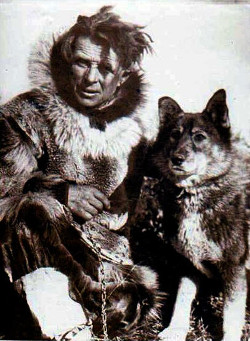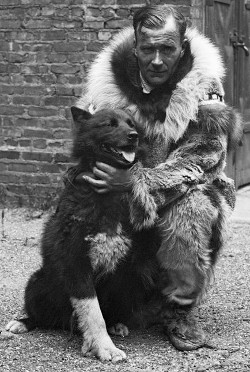The Serum Run: Men and Dogs Brave Blizzards to Stop Epidemic
Some brave men and even braver dogs saved the lives of an entire town in 1925–by racing through blizzard conditions to deliver life-saving medicine. This was the Serum Run, the inspiration for today's Iditarod Trail Sled Dog Race. The situation was grim in Nome, Alaska, in January 1925. It wasn't just the numbing cold and heavy snow and winds. Children were dying. Wheezing and gasping for air, they were suffering from diphtheria, a killer bacterial infection of the nose and throat that had one known cure: an antitoxin serum that was in short supply. Nome's doctor, Curtis Welch, was the only physician in the town of 1,400 people. Along with four nurses, he was responsible for the health and well-being of people in a few surrounding communities as well. He had ordered a resupply of the diphtheria antitoxin serum a few months earlier, but the shipment didn't arrive before the port of Nome closed for the winter. Nome had a hospital, which had 25 beds. In December of 1924, a few of the children in Nome had what the doctor and nurses thought was a sore throat or, at the worst, tonsilitis. The cases were few, and the doctor initially thought that diphtheria wasn't the cause because it was so contagious and would have infected more people by that time. But diphtheria the children did have, and diphtheria antitoxin serum the town did not have. Delivery of medicine by sea was no longer an option. 
Nome is way out west in Alaska, on the Seward Peninsula, close to Bering Strait and the Arctic Circle. In those days, the mail came to Nome by train first to the town of Nenana and then westward overland by sled dog teams, a distance of 674 miles. The duration of this sled dog trip was normally 25 days. By mid-January, a 3-year-old boy had died, two weeks after contracting diphtheria, and then a 7-year-old girl had died, the very next day. That was in Nome itself. Native children in outlying communities were also dying. The Nome City Council declared a quarantine, and Doctor Welch sent out pleas statewide and to the federal government in Washington, D.C., for aid. In no time at all, 20 people had contracted diphtheria and 50 more were at risk. The situation was urgent. Fresh in the minds of many people for miles around was the so-called "Spanish flu," which had devastated the area in 1918 and 1919, killing 2,000 people across the state. Alaska health officials got help, and serum was dispatched quickly to Anchorage, an ice-free port in the south of the state. But Nome was a long way–overland– from Anchorage. The two options open to health officials were travel by dog sled or travel by air. Airplane flight was still relatively new in the U.S., the Wright Brothers' First Flight having come only in 1903. The first winter airplane flights in Alaska had been in 1924, and the longest flight in those conditions had been 260 miles. Temperatures were so cold and conditions so hazardous as to render an airplane trip with the diphtheria antitoxin serum onboard a questionable possibility. The one advantage that such a trip would have is that it would be fast. A plane could travel up to 60 miles per hour by this time; even in bad weather, such a trip should take no more than six hours, officials thought. Planes were found and ready, and pilots were ready to take the risk, but Nome officials opted instead for the dog sled option. They were particularly taken by the claim of a musher named Leonhard Seppala that he and a team of dogs had traveled from Nome to Nulato, about halfway to Nenana, in four days. The fastest time yet recorded for a team to go all the way from Nome to Nenana was nine days. Nome's doctor, Curtis Welch, had estimated that the serum would last only six days once exposed to the harsh conditions outside the refrigeration systems of a city. The plan as it stood was for two teams, one heading east from Nome and one west from Nenana, to meet in Nulato. That way, one team wouldn't be tasked with making the entire trip. It was also decided that the teams would employ a series of drivers and a series of dogs, one after another, in a sort of relay. That way, the serum could travel faster–faster, everyone hoped, than the six days after which it was thought to be of no use. Welch had already tried administering expired serum to a Nome child; she had died. On January 27, the first team left the train station at Nenana, the serum in tow. The first driver was William "Wild Bill" Shannon. His lead dog was Blackie, and eight other dogs were onboard as well. The team encountered extreme conditions, including a temperature of -62 degrees Fahrenheit and a trail pockmarked with ruts from horse-drawn carriages. 
Shannon rested for a time, warming the serum and his dogs and himself by a fire, before resuming his trek. By the time he arrived at his handover point, in Tolovana, he had hypothermia, his face was black from frostbite, and he had lost three dogs. The next driver, Edgar Kallands, warmed the serum before setting out; when he arrived at his destination, he had to have hot water poured over his hands to get them free from the sled's handlebar. Dan Green and Johnny Folger then continued the journey on January 28. The next day, a total of six drivers–Sam Joseph, Titus Nikolai, Dave Corning, Harry Pitka, Bill McCarty, and Edgar Nollner–covered 170 miles, from Tanana to Galena. Their cause is made all the more urgent by reports of another two cases of diphtheria reported in Nome. In the wider United States, similar bad weather had brought record low temperatures to much of the country, including New York, where the Hudson River had frozen. The Nome Serum Run was a topic of conversation, and concern, throughout the country. On January 30, George Nollner, Edgar's brother, and then Charlie Evans and Tommy Patsy rushed the serum westward. Calls for plane flights of the serum were renewed but not entertained by state officials. 
Early in the morning the following day, Jack Nicolai handed off to Victor Anagick, who handed off to Myles Gonangnan, who handed off briefly to Henry Ivanoff before the serum made it into the hands of the daring Norwegian, Seppala, who was tasked with covering the most dangerous part of the route, across the treacherous Norton Sound and its notoriously unstable ice. Seppala and his lead dog, Togo, and his other dogs, who had already covered the 170 miles eastward from Nome, rushed 91 miles through the night and a raging storm, arriving in Golovin early on the morning of February 1. As the next driver, Charlie Olson, took off, word came that the number of diptheria cases reported in Nome had reached 28. The serum that the drivers were shepherding across the frozen middle of Alaska was enough to treat 30 people. Olson set off in yet another howling windstorm, his urgency at getting the serum to its destination outweighing his initial caution and safety margin. The fierce winds blew his team off the trail, and he suffered severe frostbite while putting blankets on the dogs. The team powered through a wind chill of -70 degrees F and handed off to the next driver, Gunnar Kaasen. 
Olson had arrived in Bluff, for the handover to Kaasen, at 7 p.m. on February 1. A storm was raging. Kaasen initially decided to wait a few hours for the storm to subside but then decided not to wait and headed out, his lead dog, Balto, spiriting the way forward. Conditions were so poor that Kaasen could not always see the dogs that were right in front of him. In fact, he and the team drove two miles past Solomon, his handover point, before they realized that they had overshot the mark. Seeing the conditions still bad, Kaasen decided to go on, himself. The winds were so bad at one point that they flipped the sled over, dumping the serum into a snowdrift. It was dark. Kaasen had to take off his gloves so he could feel the serum package amongst the snow, and he got frostbite on his hands. He found the package, however, righted the sled, and pushed on. Point Safety was the next relay point, and the next driver was Ed Rohn. Kaasen arrived ahead of schedule and, finding Rohn asleep, elected to push on himself. The weather was a bit better, and so Kaasen wanted to keep going. He stopped only to warm the serum, then continued on his way. In the end, Kaasen and Balto and his team got the serum, through 53 miles of snow drifts and icy winds, to Nome about 5:30 a.m. on February 2, five-and-one-half days after the relay had begun. The serum was still good; the town's sufferers had been saved. A handful of people are listed on the official death toll in Nome; Doctor Welch went on record as saying that many more native people were sure to have died from diphtheria but that he didn't have medical records of their deaths. A total of 20 mushers and 150 sled dogs made the trip. Four dogs died along the way. All of the drivers suffered to some degree from the conditions. 
Kaasen and Balto, as the driver and lead dog who arrived with the serum in Nome, got much of the attention after the fact. Kaasen and his entire team toured the West Coast for a few months and starred in a short film titled Balto's Race to Nome. Among Balto's other claims to fame is a statue of him in New York's Central Park. The statue is dedicated to all the dogs who took part in the Serum Run. Balto died at the age of 14, in 1933. He can be seen at the Cleveland Museum of Natural History. Seppala and his team, including Togo, toured the country and appeared in an advertising campaign. Togo died in 1929, at the age of 16. He can be seen at the Iditarod Trail Sled Dog Race Headquarters in Wasilla, Alaska. "Wild Bill" Shannon and his lead dog, Blackie, briefly toured as well, but the focus of the public was very clearly on Balto and Togo and Kaasen and Seppala. Air mail eventually replaced dog sled mail delivery, with the last dog sled route closing in 1963. The advent of snowmobiles reduced mushing to a recreational pursuit. In 1973, however, the advent of the Iditarod race renewed interest in mushing. The Serum Run inspired the Iditarod. Seppala was an honorary musher for the first seven years of the race; other awards associated with the race are named for him. The route of the Iditarod more closely parallels that of the All Alaska Sweepstakes; the 1910 champion of that event was Seppala. |
|
Social Studies for Kids
copyright 2002–2024
David White




